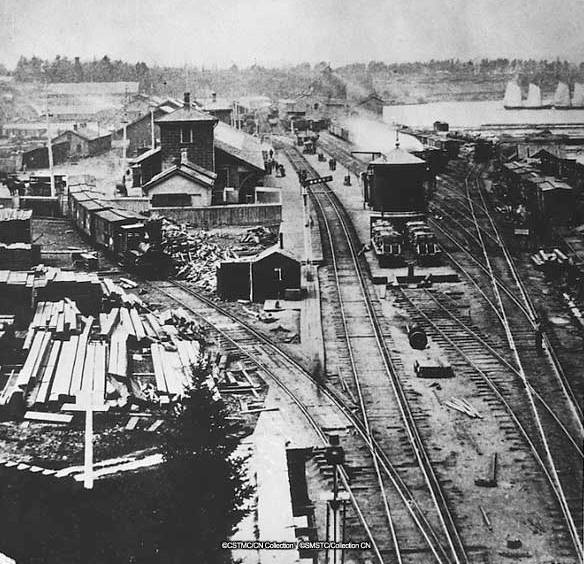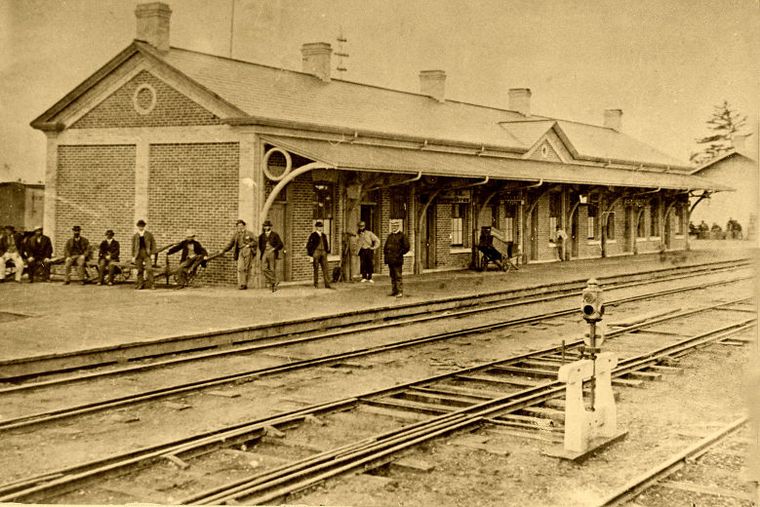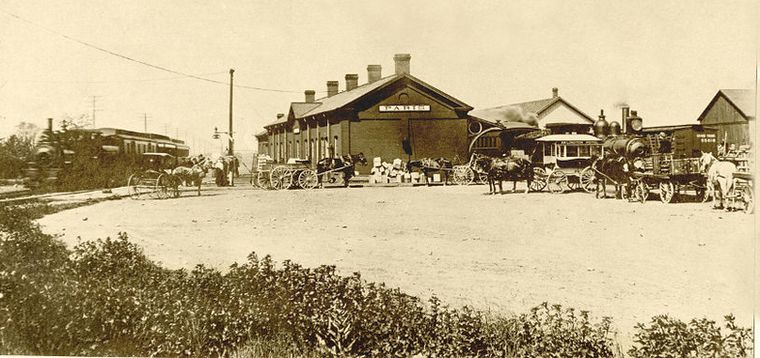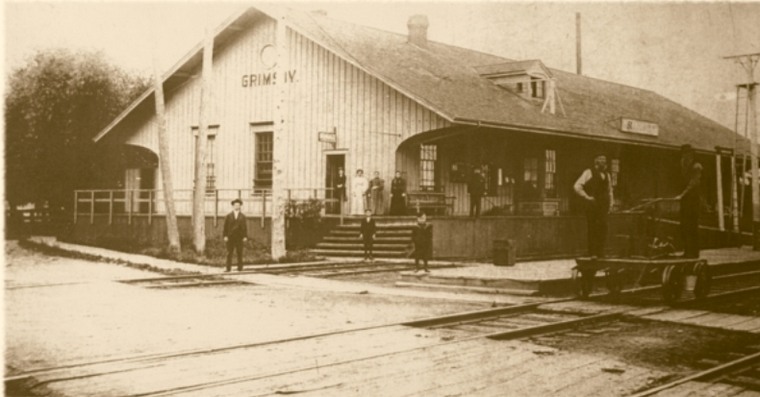Great Western Railway
Location: Across Ontario; 1855-1882, headquartered in Hamilton, Ontario.
Map of G.W.R. lines in Ontario 1879-1880
[293 KB]
Map of Hamilton in 1858 [895 KB]
Toronto station
new and photos after closed.
Niagara
Falls Suspension Bridge
In the early 19th century, Southern Ontario was dotted with settlements
separated by expanses of rough, tree-covered terrain. No railway existed
at that time; the only modes of transportation were boat, horse, or
foot.
In March of 1834, a group of businessmen combined efforts to obtain
a charter for the name and construction of a railway,
the London and Gore. This railway was to run from London, Ontario, to
Burlington Bay in the District of Gore. Among the men involved was Allan
MacNab, who was later to become Prime Minister.
Financial resources were difficult to obtain, so the project was all
but abandoned until 1845, when the charter was renewed and amended.
The name of the fledgeling freight and passenger railway was changed
to The Great Western Railway (G.W.R.), and its mileage was expanded
to cover the area between Windsor in the west and the Niagara River
in the east. This new run was not originally intended to pass through
Hamilton; it was MacNab who arranged for the line to bypass Brantford
in favour of a route along Lake Ontario. He felt that Hamilton would
be a "greater strength as a base for the promotion of railways."
(Beer, p. 209) Once constructed, the G.W.R. would be the first railway
in the city of Hamilton.
Great Western Railway's Locomotive #113, which was built in Rhode Island
in 1871 (click for a closer look)
Construction was begun on the G.W.R. in 1851, after the
municipalities along the projected route bought great amounts of stock
to finance the effort. Materials and locomotives had to be brought in
from England and the United States, making their way to their final
destination by ox-cart. On January 17, 1854, the first train set off
from Niagara to Windsor. The official celebration in Hamilton took place
two days later. Business in the city was suspended as residents crowded
downtown to watch the parade and fireworks. The trains at the time ran,
at most, 30 miles per hour, and the full 229-mile trip from Niagara
to Windsor took seven hours.
The first year of the railway's existence proved to be successful for
Hamilton. Industries were drawn to the city because of its location
at the head of Lake Ontario, and because of the G.W.R.
In 1852, the Hamilton and Toronto Railway Company was incorporated to
construct a line between Hamilton and Toronto. This line would be amalgamated
as the Toronto Branch of the G.W.R. in 1857. Hamilton became the official
headquarters of the G.W.R. in 1855.
On March 12, 1857, a tragedy occurred just west of Hamilton. A passenger
train on its way from Toronto became derailed due to a broken axle and
crashed into the icy waters of the Desjardins Canal, below the swing
bridge. Fifty-nine lives were lost, and the mayor proclaimed March 16
to be a "Day of Humiliation".
Hamilton
Public Library online material

Great Western Railway yards and station (Bay and Stuart
Streets) in Hamilton, 1870
In 1860, shops were set up along the bayfront where engines
would be built. Nine years later, the G.W.R. constructed a rolling mill
in the city to reroll old and inferior iron rails. The G.W.R.'s rolling
mill was the very first in Ontario, and one of the first industries
in Hamilton. However, it would not be the last; in fact, it was the
very presence of the mill, the shops, and the railway itself that led
to the development of Hamilton as a manufacturing city: "The iron
and steel industry came to Hamilton on a large scale when the locomotive
shops and rolling mill of the Great Western Railway were set up here."
(Evans, p. 177)
Unfortunately, in 1872, iron nails were being increasingly replaced
by steel. Additionally, British investors were buying up large numbers
of stocks, while the municipalities were selling theirs. These two factors
led to the closing of the G.W.R. Rolling Mill. (The Rolling Mill eventually
became the site of the Ontario Works plant of the Steel Company of Canada.)
Eventually, the Canadian Board of Directors was dissolved, and the G.W.R.
was entirely under British control.
In 1875, the G.W.R. built a new passenger station on Stuart Street,
in the north end of Hamilton. The previous building was considered to
be unsuitable for such a prosperous city.
By 1879, increasing competition from other railways (especially from
the Grand Trunk Railway [G.T.R.]) and poor management from London, England,
led to a tense financial situation. It appeared that the only alternative
to giving up completely would be to amalgamate with the G.T.R. On August
12, 1882, the Great Western Railway became a part of the Grand Trunk
Railway. The headquarters of the G.W.R. (as a branch of the G.T.R.)
were moved to Montreal, Quebec. "On that date, Hamilton lost its
railway." (Wentworth Bygones, no. 11, p. 43)
In 1923, the G.T.R. itself was taken over by the Canadian National Railways
(C.N.R.). The original Stuart Street station of the G.W.R. (built in
1875) still stands, but is abandoned. It had been used as a station
for the G.T.R., and then the C.N.R., until the latter built its own
new station on James Street North at Murray Street in 1930.
INDUSTRIAL HAMILTON: A TRAIL TO THE FUTURE
The Great Western Railway
Material is from Canada's Digital Collections (CDC). CDC
was operated by Industry Canada between 1996 and 2004 to provide young
Canadians with skills and experience in preparing digital Canadian content
of local, regional and international interest. The various collections
that were produced during this time period have now been archived by
Library and Archives Canada. It is no longer online and was resurrected
here from the Wayback Machine Internet Archive.
It is difficult to overestimate the influence that the
Great Western Railway had on the development of Hamilton. A few of the
companies that set up shop in Hamilton between 1850 and 1882 are:
The
Hamilton Bridge and Tool Works
Ontario Rolling Mills
Hamilton Wire and Iron Fence Company
Other companies that are or were located on the tracks of the Great
Western/Grand Trunk/Canadian National in Hamilton are:
The
Steel Company of Canada Hilton Works (est. 1910) (Burlington Street)
Dominion
Foundries and Steel (1912) (Depew Street)
Otis(-Fensom)
Elevator (1902) (Victoria Avenue)
Westinghouse Air Brake Manufacturing Company (1896) (Sanford Street)
Canadian
Westinghouse (Westinghouse Canada) (1903) (Sanford Street)
International
Harvester Canada Works (1902) (Sherman Avenue)
The decision of Sir Allan MacNab to route the Great Western Railway
through Hamilton made this city the industrial hub of Canada.
References:
Beer, Donald R. Sir Allan Napier MacNab. Hamilton: Dictionary of Hamilton
Biography, Incorporated, 1984.
Clipping File - Hamilton - Railways - Great Western Railway. Special
Collections, HPL.
Evans, Lois C. Hamilton: The Story of a City. Toronto: The Ryerson Press,
1970.
Great Western Railway Timetables, 1879-1880
Head-of-the-Lake Historical Society. Wentworth Bygones. Hamilton, nos
5, 9, 11.
Map Collection - Hamilton, Canada West - 1858. Special Collections,
HPL.
Picture Collection - Hamilton - Railways - Great Western Railway. Special
Collections, HPL.
Thompson, Norman. Canadian Railway Development From the Earliest Times.
Toronto: The Macmillan Company of Canada, Limited, 1933.
Paris Junction

Station built to last for a century! 1870

Busy day in 1907. Iron horses and real ones. Not a horseless carriage
in view!

Grimsby c.1855
GTR CNR and subsequent
business uses.
